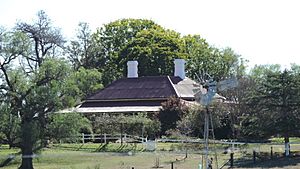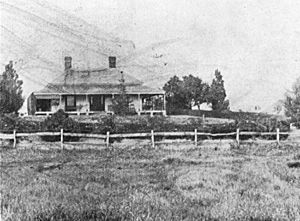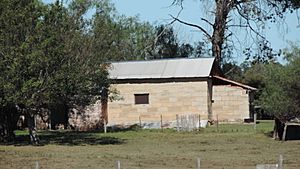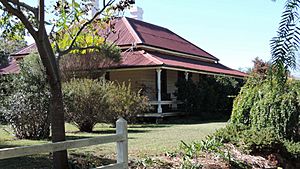Assmanshausen Winery facts for kids
Quick facts for kids Assmanshausen Winery |
|
|---|---|

Assmanshausen Winery residence, as seen from Sandy Creek Road, 2015
|
|
| Location | Serisier Road, Toolburra, Southern Downs Region, Queensland, Australia |
| Design period | 1870s - 1890s (late 19th century) |
| Built | c. 1870 - c. 1881 |
| Official name: Assmanshausen Winery and Residence (former), Toolburra Vineyards | |
| Type | state heritage (archaeological, built) |
| Designated | 6 January 1999 |
| Reference no. | 601289 |
| Significant period | c. 1870-c. 1881 (fabric) 1864-1920, 1920-1940s (historical) |
| Significant components | garden - bed/s, fence/wall - perimeter, laundry / wash house, residential accommodation - main house, winery, terracing, cellar, meat house, trees/plantings |
| Lua error in Module:Location_map at line 420: attempt to index field 'wikibase' (a nil value). | |
Assmanshausen Winery is a historic former winery located on Serisier Road in Toolburra, Queensland, Australia. It was built between about 1870 and 1881. This important site is also known as Toolburra Vineyards. It was added to the Queensland Heritage Register on 6 January 1999, recognizing its special historical value.
Contents
History of Assmanshausen Winery
The Assmanshausen Vineyard was started in the 1860s by Jacob and Elisabetha Kircher. They were German immigrants who were among the first in the area to produce wine on a large scale. By the late 1800s, Assmanshausen's wines were famous across southern Queensland. The winery was a popular place for visitors to the Warwick area.
Early Settlers and Farming
Jacob and Elisabetha Kircher arrived in Queensland in 1855. Jacob first worked as a gardener at Canning Downs Homestead near Warwick. In the early 1860s, the Kirchers started farming. In December 1861, Jacob bought two pieces of land, each about 45 acres, near Sandy Creek. This was about 7 miles northwest of Warwick.
The Kirchers were some of the first farmers in the district. They cleared their land and tried growing wheat. When that didn't work well, they decided to grow grapevines. They planted their first 1,000 vines around 1864. By 1870, they had opened Assmanshausen Winery. They named it after a famous wine region in Germany.
Wine Making in Warwick
Growing grapes and making wine in the Warwick area was started by German immigrants in the mid-1800s. By 1861, Germans made up almost 10% of the population in the Warwick region. Many of these settlers, like the Kirchers, started vineyards in the 1860s.
By the mid-1870s, several vineyards were operating along Sandy Creek. Most vineyard owners also grew other crops like wheat or corn. They all made wine right on their property. They built cellars, often made of stone and partly underground, to make and store their wine.
Assmanshausen's Success
By 1876, Assmanshausen was the main vineyard and winery in the Warwick area. It had 10 acres of grapevines. They grew both white grapes (like verdelho) and red grapes (like Mataro). Jacob Kircher even invented a special horse-drawn machine to help weed around the vines.
Kircher made "unfortified wines," which are dry wines made without adding sugar or spirits. His wines won many awards at exhibitions in Warwick and Brisbane.
The Winery Building
The Assmanshausen winery building was made of cut stone. It had three levels:
- An underground cellar.
- A ground-level workroom.
- An attic space under a steep shingled roof.
The attic had 12 air shafts to keep it cool. The cellar also had 6 air shafts built into its stone walls. Kircher had his own unique way of making wine. The grape juice was pumped up to the attic for fermentation. Then it flowed through pipes down to the underground cellar to age in large wooden barrels.
Growth and Recognition
In the 1870s, wine production became very important in the Warwick district. Assmanshausen wines became very well known. By 1881, Kircher had modern screw presses. His winery was considered one of the best in Queensland.
At this time, the presses were in the attic. The grape juice would then flow down to the ground floor for fermentation. From there, it was piped to the underground stone cellar to age. Kircher had 11 acres of grapevines near his house. He also farmed other crops and raised sheep.
The Kirchers' home was also very impressive. In 1881, a reporter called it "the neatest, best finished, and most comfortable dwelling I have ever seen among Queensland farmers."
Exporting Wine
Assmanshausen was highlighted in a report about wine-making in Queensland in 1889. It was one of the oldest vineyards in the area. Jacob Kircher was the only Queensland wine-maker exporting wine to Britain or Europe at that time.
By 1901, the vineyard was still 10 acres. Kircher focused mostly on wine production. The cellar was still considered one of the best in Queensland, holding about 18,000 gallons of wine. Assmanshausen wine was usually aged for 7 or 8 years before being sold. It was very popular across southern Queensland. Kircher won about 60 prizes for his wines.
Changing Hands and Decline
In March 1902, Assmanshausen Farm, Vineyard, and Winery were put up for sale. It included 90 acres of good farmland, with 10 acres of grapevines. There was also a large 8-room timber house and the stone winery building.
Jacob Kircher passed away in 1903. Since the Kirchers had no children, the property went to a trustee. After Mrs. Kircher died in 1912, the property was passed to her American nephew, Michael Kircher, in 1915. He had been managing the winery since about 1902.
In the early 1900s, after Australia became a federation, wine production in Queensland faced tough competition from other states. In 1920, Henri Macquarie Serisier bought the vineyard and winery from Michael Kircher. Serisier had experience in wine-making from both Australia and Europe. He changed the famous Assmanshausen name to Toolburra Vineyards. He also planted many new grapevines, including table grapes. By 1922, he had about 65 acres of grapes.
HM Serisier stayed at Toolburra Vineyards until a few years before he died in 1942. In 1932, he transferred the property to his son, Kelvin Eugene. Kelvin continued the vineyard through the 1930s. However, when World War II started, he joined the RAAF. The vineyard then declined, and the winery stopped making wine in the early 1940s.
After the winery closed, some parts of the building were removed, like the timber extension and the shingled roof with its attic. The property remained with the Serisier family until 1980.
What the Winery Looks Like Today
The former Assmanshausen Winery and Residence are located on a low hill. This is just north of where Sandy Creek and Serisier Roads meet, about 11 kilometers northwest of Warwick. The Sandy Creek area still feels like the countryside.
The Winery Building
The winery building is a rectangular structure made of local sandstone. It has a ground-level workroom and a deep cellar. The roof is now made of galvanized iron, replacing an older steep shingled roof. You can still see marks on the beams where the old roof was.
On the south side, there's an open extension with a skillion roof and timber posts. At the west end, a small sandstone extension has a large timber door. This door lets you go up to the workroom or down a steep timber stair to the cellar. On the north side, there's a small brick extension. The building has small windows on the north and south sides. These were for ventilation, not for light.
Inside the Winery
Inside, much of the original timber is still there. This includes heavy, square-cut timber beams and posts. The wide timber boards of the workroom floor form the ceiling of the cellar. There's an opening in the workroom floor. This was large enough to lower barrels into the cellar below.
The cellar has an earth floor. There are some dips in the floor that might show where the barrel racks used to be. Six air shafts are built into the cellar walls. These shafts slope upwards to just above ground level. They helped keep the temperature cool and constant, around 50 degrees Fahrenheit (10 degrees Celsius).
Today, the workroom is used for storage. The cellar is empty. No wine-making equipment remains in the building. The original vineyard, which was planted near the winery, no longer exists. However, archaeologists could still find clues about the old verandahs and timber extensions.
The Residence (House)
The house is close to Serisier Road. It faces south towards Sandy Creek Road. It sits in a garden with old trees and shrubs, including conifers and pepperina trees. There are also early terraced garden beds.
The house is made of timber and has a double hipped roof of galvanized iron. It sits on low timber stumps. The outside walls are covered with 8-inch wide pine boards. The main part of the house is surrounded by wide verandahs (porches). The back verandah and parts of the side verandahs have been enclosed. Where they are still open, the verandahs are supported by timber posts.
Inside the House
The main part of the house has four rooms and a large entrance area. From the central front entrance, you enter a vestibule. On each side of the vestibule is a bedroom with large windows. Beyond the vestibule is the parlor (living room). The dining room opens off the parlor.
These rooms have beautiful cedar woodwork. This includes door and window frames, decorative moldings, and skirting boards. There's also a decorative timber arch between the entrance and the parlor. Each of the four main rooms has a fireplace with original plaster. The original pine lining on the walls and ceilings has been covered by newer materials. Some doors have old decorative wax paper lights above them. Several rooms have old decorative pressed metal decorations above the windows.
French doors open from the parlor onto the western verandah. This part of the verandah has been enclosed to create a small room. The back verandah has been enclosed and made larger to create a modern kitchen and living room. This replaced an older kitchen and bedroom area. The northern end of the eastern verandah has also been enclosed and extended. This area now holds a guest bedroom, bathroom, and laundry. It also provides a walk-in closet for the front bedroom on the east side.
The Grounds
The grounds behind the house have old trees and shrubs. There are also several timber buildings, including a meat-house and a wash-house. The house property is marked by fences. There's a white timber fence along the western and southern sides. Wire fencing is on the eastern and northern sides. Two large pine trees, important to the garden, are just outside the southern fence.
Why Assmanshausen Winery is Important
The former Assmanshausen Winery was added to the Queensland Heritage Register on 6 January 1999. This means it is recognized as a very important historical site.
- Shows Queensland's History: The winery, built around 1870, shows how vineyards and wineries were among the first important businesses in the southern Darling Downs. The well-built house, finished by 1881, shows how successful the winery was. It also shows how its immigrant owners wanted to build a good life in their new country.
- A Rare Example: Even though part of the winery building is gone, the sandstone winery is a rare and important example of its kind.
- Potential for New Discoveries: This place could still teach us more about its structure through archaeological digs. This would help us understand more about wineries and wine-making in Queensland's past.
- Shows How Wineries Worked: The winery still has many original parts, like the cut sandstone and heavy timber beams. It also has design features like the underground cellar, air shafts, and small windows. These help us understand how a 19th-century Queensland winery was built and how it worked. The way it was designed to control temperature is especially interesting.
- Beautiful to Look At: Both the winery and the house are very appealing. The house, with its old style, wide verandahs, red roof, and white chimneys, surrounded by old trees, is a well-known sight in the area. The winery also has a rustic charm, with its underground cellar and pleasant rural setting.
- Important to the Community: Assmanshausen Winery has a strong connection to the community. It was a popular tourist spot in its time. The names Assmanshausen and Toolburra Vineyards are well known in Warwick's history.
- Connected to Important People: The place is important because of its strong connection to Jacob Kircher. He made a big contribution to the wine industry in southern Queensland from the 1860s until he died in 1903. It also shows the important role early German immigrants played in Queensland's development.




